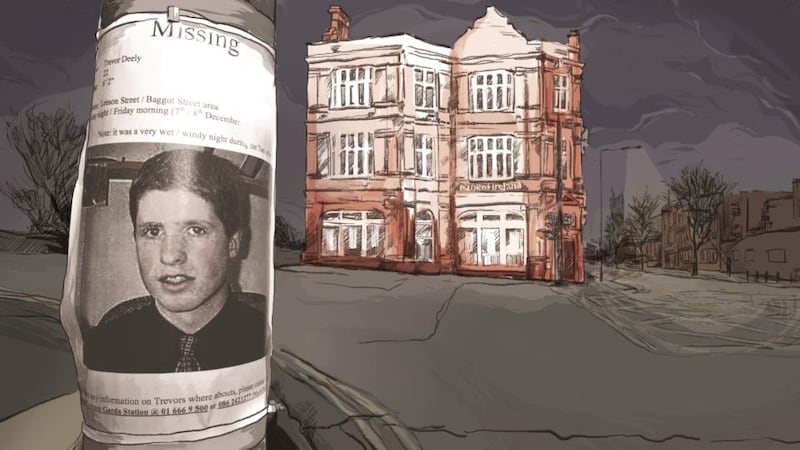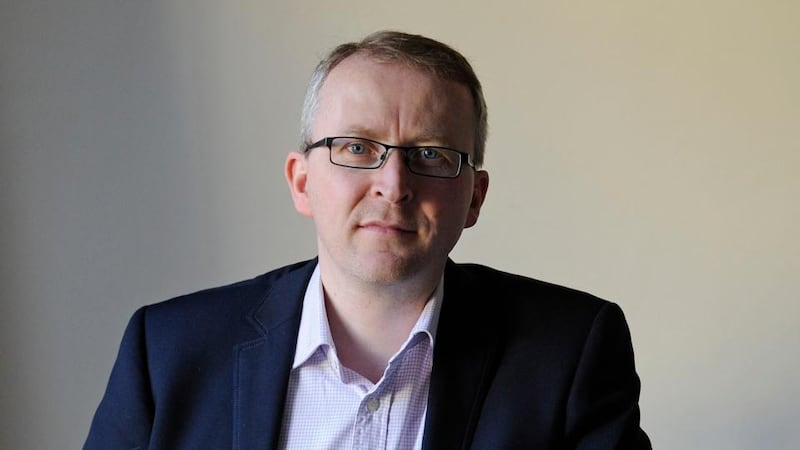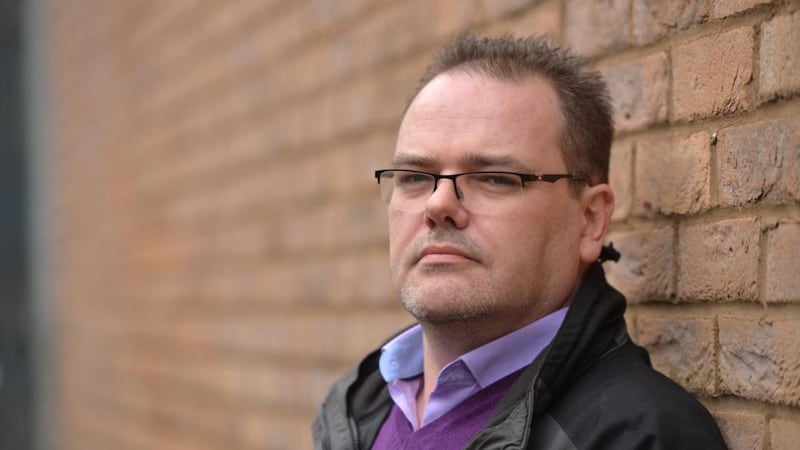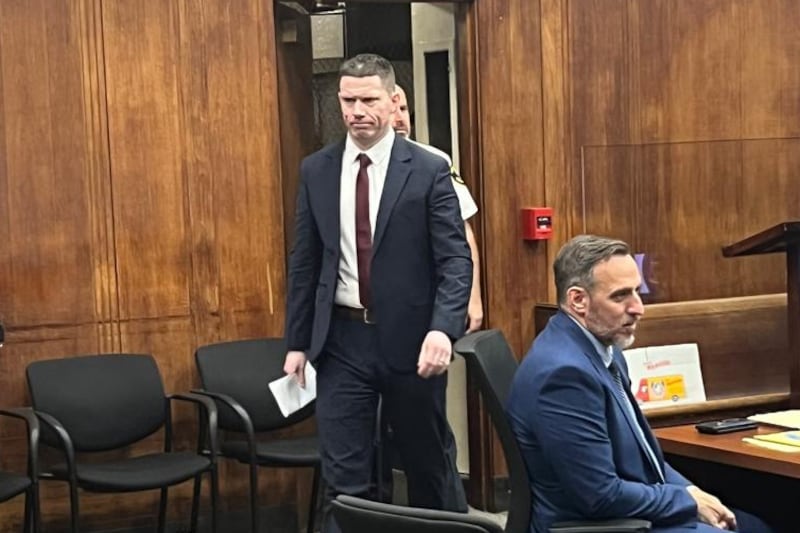Trevor Deely vanished from the streets of Dublin in the early hours of December 8th, 2000. His disappearance at the age of 22 was the subject of a high-profile search and publicity campaign, but no trace was ever found. In the first of a three-part report, Rosita Boland re-creates the days and hours before Trevor Deely’s disappearance. Part 2 chronicles the search for the missing man. Part 3 explores the effect on the Deely family
Michael and Ann Deely of Naas, Co Kildare, have four children: two sons, Mark and Trevor, and two daughters, Michele and Pamela. What makes their family extraordinary is that nobody has seen or heard from its youngest member for 14 years, two months and 20 days.
At the age of 22, in the early hours of December 8th, 2000, Trevor Deely vanished. His disappearance in Dublin shortly before Christmas became the subject of possibly the highest-profile search for a missing person in recent years. Yet since the moment he walked away from a CCTV camera on Baggot Street Bridge, in the middle of Dublin, nobody has been able to establish what happened to him. The camera recorded him passing by at 4.14am, heading towards Haddington Road.
"My six-year-old said to me last night, 'What do you think, Mummy? Do you think he's lost or do you think he's dead?' " says Michele Deely, Trevor's sister. She wasn't able to give her daughter an answer, but she wishes she could. "I want closure. I want to know where he is, and I want to know what happened after that last clip on the CCTV footage, and I want to stop all the nightmarish thoughts that you can have, and I want to stop the not knowing.
“Nothing has been found. There’s been zero: zero information or findings. I don’t believe people vanish. That makes no sense to me. That’s the most agonising thing. It actually starts to hurt your brain when you think about it.”
Mark Deely, Trevor's brother, says, "In the year afterwards I had the best-of-intentioned people coming in to me at work, saying, 'Ah, sure, poor Trevor, he's in a happy place now.' They just assume missing equals dead. That's human nature. But where's the proof? I am not willing to believe that aliens came down and snapped him away. So something happened, and if something happened somebody knows."
His father, Michael, says, “We’re lucky that we’ve held together. I know some families have broken up when someone goes missing.”
December 2014 marked the 14th year of Trevor's disappearance. On the 10th anniversary an "age progression" image of Trevor was released, showing what he might look like today. Michael Deely participated in a press conference organised by the Garda, of which it later posted footage on YouTube.
During that appeal he spoke of the “absolute nightmare” the family had had to deal with. “We remain positive until we know precisely what happened. We’re just keeping the hope up that this can turn right and come right,” he said.
He also said, hopefully, of the age-progression photograph, that Trevor had worked in information technology, “and we’ve often been told he loved that work, and if he is around someplace and working he’s likely to be working in an IT situation.”
Michael Deely asks only one thing of the well-meaning people who continue to ask about Trevor and how the family is coping: “A kind word. It’s not that they can solve anything for you but that they have the kind word for you. All that’s necessary is empathetic support.”
One thing the Deelys did right from the beginning was not allow the media into their home. “Our home is our refuge,” Michael says.
Ann Deely does not give interviews. The Irish Times requested one. Her family said that the disappearance is too traumatic for her to talk about but that she is anxious to acknowledge the kindness and support she has received for the past 14 years through her friends at Naas tennis club. Pamela Deely also felt unable for an interview.

The perfect employee
Trevor Deely grew up in Naas. He was tall – over six feet – with reddish-blond hair and a distinctive gait, walking with his arms straight down by his sides. An easygoing teenager, he was not particularly sporty or academic, like his older siblings, but he liked maths.
After school, like many others, he was unsure about what to do next. He tried studying business at Waterford Institute of Technology, working part-time in a supermarket, but dropped out in his second year.
Through his sister Michele he found a computer course in Dublin. “He took to it like a duck to water,” Michael Deely says. “It was like turning a key in a lock,” his sister says. “He finally found what he really enjoyed, and he seemed to be really good at it as well.”
After he finished his course he had three job offers. He asked his father for advice about which one he should take. “I said, ‘Take the bank. Banks are safer than any of the others.’ ”

In May 1999 Trevor started working at Bank of Ireland Asset Management, at its office in a distinctive neo-Georgian building by Leeson Street Bridge. He was in the IT department, in a team of about 10 that sat together in an open-plan office. Daragh Treacy, their manager, worked in an adjoining office that had sliding glass doors.
“He was almost the perfect employee: he was reliable, nothing was too much trouble, he was hungry to learn, he was ambitious and he mingled well with everyone in the company,” Treacy says.
“He was a very happy guy. He had this big, happy face on him. He was one of these nice guys to be around. He was very positive. He never bitched about other people or gave out about them. He had a very good work ethic. He was very trustworthy. I’m not just saying this because of the situation, but Trevor was a good guy.”
Three ale drinkers
Trevor’s closest friend through adolescence into adulthood was Glen Cullen. They met when they were in first year of secondary school in Naas. “I never had an argument with him, in any shape or form. Not about girls, not about anything,” Glen says. “We did practically everything together.
Conleth Loonan, who is also from Naas, was part of their network of close friends. “Trev was a jovial character. He was always in good form,” he says. “He had a good head on his shoulders as well: he was doing very well at work, so he had a serious side to him. He took work seriously.”
In their early 20s the three went to pubs and clubs together. In Naas, Thomas Fletcher’s was their local, and Smithwick’s was their drink. “We were all ale drinkers, which was quite unusual for that age group,” Conleth says.
They enjoyed themselves on their nights out, but “it was never falling around the place”, Glen says. It was before the smoking ban, and Trevor smoked either Benson & Hedges or Marlboro Lights, preferring to use a Zippo lighter rather than matches.
As Glen recalls it they had the same mobile phones, Nokia 1610s – a common model at the time – which is how they always communicated; Glen didn’t use email at the time.
On the first Saturday in October that year, the 7th, Kerry won the All-Ireland football final in a replay against Galway. A big GAA fan, Mark Deely travelled to Dublin from his home, in Castlebar, Co Mayo, to attend.
His younger brother went to the match with him, as did a group of Mark’s friends. They all went out together afterwards and had a great night. Seven years the elder, Mark says Trevor was no longer his little brother by then but more of a peer.
“It was a time when I was really getting to know him. His working life was just starting; he was just starting to have his own money. We might as well have been the same age then.” That was the last time Mark saw his brother.
Anchorage, Alaska
When Trevor was at Bank of Ireland Asset Management, Glen Cullen was working as a long-haul flight attendant for Aer Lingus, mostly on the Los Angeles and New York routes. As an Aer Lingus employee Glen was entitled to free and discounted flights for a number of family and friends. Shortly before Trevor’s disappearance Glen arranged for Trevor to be named on his Cara discount pass, for a holiday.
The last time Glen saw Trevor was at Dublin Airport in late November 2000, going through United States customs on his way to Alaska.
“He travelled from Dublin to LAX – Los Angeles – and then as far as I’m aware he got a connecting flight straight on up to Anchorage. He went by himself, to see this girl up in Anchorage that he had met in Dublin that summer. I never met her. She wasn’t here for long.”
On an earlier night out the two friends had been discussing the woman. Glen had said to Trevor, “Ah, look, I bet you won’t go over to see her.” “And he said, ‘Well, you never know.’ And I said, ‘I bet you you won’t.’ And he said, ‘I bet you I will.’ ”
Glen used his pass to get Trevor a return flight – a round trip of 24,000km – for what he thinks was no more than £80. Why Alaska? It’s an unusual destination for a short break from Ireland. “I think he just had the time off work, and had the few quid, and I had the free flight,” Glen says. “That’s what I always put that down to. I’m nearly positive he wouldn’t have gone to Alaska if I hadn’t the free flight for him.”
As Michael Deely tells it, Trevor had met a couple of girls from Alaska in Ireland through his friends in Naas and the nearby town of Kill. The girls were at university in Anchorage.
“He picked up the phone one day it seems, or got on to his email. He was into email; he’d have had all their emails. And he emailed these girls in Alaska to say he was free for these few days or something. I think the girl mailed back – Michele saw the reply to it – to say she was too busy at the moment, she was trying to get her exams, but Trevor sort of said, ‘Oh, Janey, I’m only free now, and we’ll be very busy in the office, and I don’t know when I’ll get away again.’ So he sort of persisted with it anyway and got out there.”
Mark Deely says, “Alaska was just a holiday, like going to Ibiza or Lanzarote – a bit more unusual, okay. Wasn’t there an ex-girlfriend over there or something as well? Maybe he had the hots for her still or something. I don’t know how the opportunity arose for him to go to Alaska – was it through the ex-girlfriend or was it through another friend? Logically it had to be through the ex-girlfriend.”
Home to Naas
The last time Trevor’s parents saw him was in the family home the day he arrived home from Alaska. “He had only got into Dublin Airport that morning and came down on a bus to Naas, and he was yawning all the time with tiredness,” Michael says. “I remember him sitting on the couch at home and Ann was cooking a big steak for him.”
Michael Deely, who worked at the time for Bord Bia, was en route to an evening meeting outside Dublin when they fleetingly passed each other in the house. He thinks this was Tuesday December 5th, just two days before his son went missing.
As Trevor sat on the sofa, struggling with jet lag, he told his parents about the icebergs he had seen in Anchorage, which had fascinated him. “I said to him, ‘Sure, I’ll hear more about it when you’re down the next time,’ ” Michael says. Trevor also told them that “he wasn’t going to come down the next weekend, which was the weekend that it happened”.
Michael left, and Trevor stayed for only a few hours at the family home before leaving for Dublin, as he was due back at work the next day.
But Trevor must have changed his plans about not coming home to Naas the weekend of December 9th, because, according to Glen and Conleth, the three of them were due to meet at Fletcher’s that Saturday night.
Glen had been talking to him on the phone since his return. “I said, ‘Don’t tell me how you got on in Alaska. I’ll meet up with you next weekend. I’ll be off then, and we’ll hook up. We’ll have a good old chat and a chinwag then, and you can tell me all about Alaska.’ ”
The night of the party
The bank Christmas party was scheduled for Thursday, December 7th. Some people, including Trevor, went to Copper Face Jacks first. Then everyone gathered at the Hilton Hotel on Charlemont Place for a “sit-down meal and a band”, Daragh Treacy says.
It was also the night of Michele Deely’s Christmas party in London. She hadn’t seen her brother since Easter, something “that was pretty hard for me to stomach afterwards”, she says. “It still is.”

The two had exchanged a number of emails that week about Christmas, her plans to travel home, and family gifts. Their last exchange was about Trevor’s shirt size. That weekend in London, before anyone knew Trevor was missing, Michele bought a Christmas gift for her brother, a light blue Ralph Lauren shirt. She still has it.
Back in Naas, Glen and Conleth were on a night out. At one point Trevor called Glen, who couldn’t hear him against the hubbub of the office party at the Hilton. “I said, ‘Trev, I’ll call you back.’ ” It was late, Glen thinks, between 11pm and 11.30pm. “Then he called me back. I missed the call.” One way or another, between the background noise and missing each other’s calls, they never had a conversation.
After the Hilton a number of people, including Trevor Deely and Daragh Treacy, went on to Buck Whaleys nightclub, on Lower Leeson Street.
Taxi strike
The weather forecast for eastern counties for the postmidnight hours of December 8th, 2000, as carried in this newspaper, read: “Heavy rain overnight . . . Winds will back to the northwest or west and remain very strong and gusty, gusts possibly as high as 60 or 70mph.”
On that wet and wild night there was a taxi strike in Dublin. This was to become significant in the investigation of Trevor’s disappearance, as it meant that fewer potential credible witnesses were out and about.
“There were no taxis that night, and taxi men are often your information, because they’re out there,” says Det Sgt Michael Fitzgerald, who was involved with the Deely case from the beginning.
Supt Michael Cryan, the Deely family’s liaison officer, says, “They tend to be sober, too, so they know what they’re seeing.” (Supt Cryan, the family’s fourth liaison officer, is shortly to be replaced by a fifth, as Cryan is being transferred.)
Daragh Treacy says the taxi strike would not have unduly bothered Trevor, who regularly walked to work. He was sharing an apartment in the Renoir complex, on Serpentine Avenue in Ballsbridge, with two girls, one of them a friend of Michele’s.
But the rain was lashing down that night, as Daragh recalls, and Trevor did not have an umbrella with him – which he would have realised as soon as he stepped into the night for his walk home.
After Buck Whaleys
Karl Pender, a computer operator who also worked in the IT team at Bank of Ireland Asset Management, had not been at the Christmas party. He was reluctantly working the night shift because his shift partner, who had offered in advance to cover for him, had taken ill during the week and was in hospital.
Karl was the only member of the team in the department that night – until Trevor arrived unexpectedly, “drownded wet”, not long after 3.25am, the time at which he had left Buck Whaleys. “I was surprised to see anyone. The last thing you expect is to see anyone calling into the office after a Christmas party,” he says. “When he came in he asked me did I have time for a cup of tea. I said, ‘Yeah, sure.’ I just had something to do at that immediate time, and he said, ‘Grand. I just need to log on for a minute.’ ”

While Karl finished his task Trevor logged on to his computer at a nearby desk. “I’m not sure if he was doing something to do with work or sending an email. I never asked him.”
What did Trevor do at his computer that evening? “I don’t know if he sent an email or not. I can’t recall what the guards said,” Michele Deely says. “It wasn’t anything significant, put it that way. It wasn’t like he sent an email about some plans. It was nothing significant at all.”
Mark Deely says, “It’s not important to me if he was sending emails or not. All it proves to me is that he’s not completely out of it on a night out. I was told his computer was checked. That there was nothing on it.”
After 10 minutes or so Trevor and Karl went to the office canteen. Trevor had coffee; Karl had tea. Trevor had “taken a few drinks, all right”, says Karl, “but I wouldn’t consider him as drunk. I’d probably say I’d have seen him worse on other nights.”
Phoning a friend
They chatted about the party, and who had been there. Karl says Trevor was in great form. Then Karl had to go back to work. Trevor collected one of the corporate golf umbrellas routinely left lying around the office, said goodbye, left the building and went back out into the wet night.
At his home in Naas, Glen was asleep. He habitually left his mobile phone beside his bed, switched on. That night his phone, which needed to be charged once every seven to 10 days, was charging downstairs in the kitchen. “I had never, ever left it downstairs on charge before,” he says ruefully. He slept through the sound of his phone ringing downstairs.
When he went into the kitchen that morning – December 8th, 2000 – and picked up his phone, Glen found a voicemail message from Trevor. “It said, ‘Hi, Glen, I’ve missed you there. Just on my way home, all going good, I’ll talk to you tomorrow.’ Or words to that very close effect.”
The voicemail was left, he thinks, at 3.55am, 4am or 4.05am. He can’t be certain, because he deleted the message after he listened to it.
Had he wondered why Trevor had called him at a time when Glen was likely to be asleep? “I didn’t think it one bit strange, because we were so close. He was my best friend. It wasn’t going to alert me to anything suspicious. Definitely not.”
Were they in the habit of calling each other in the middle of the night? “No. It would only be if he was out and I was out as well.” Glen doesn’t remember having ever been woken during the night by a call from Trevor.
Det Sgt Fitzgerald says, “The last activity on his phone was at 4.06am on Friday the 8th.” The Garda never asked Glen for his Nokia, so it could retrieve the last voicemail Trevor is known to have left.
“If he’d left a message that disturbed him” – Glen – “it’s one thing, but a call saying, ‘Hello, I’ll ring you tomorrow,’ doesn’t mean it’s relevant,” says Supt Cryan.
In the minutes after the call, as Trevor Deely walked along the Grand Canal, holding the golf umbrella, the rain continued to fall. He had no known contact with another person after this point, but he was recorded on CCTV. This footage was located through the persistence of Trevor Deely’s friends.
Finding the footage
There were fewer CCTV cameras in 2000 than there are today, but there was one outside a Bank of Ireland building on the corner of Baggot Street Bridge and Haddington Road now occupied by a pizza restaurant.
Conleth Loonan worked at the time for a communications company that supplied CCTV equipment. “Being in the business, I would have known back then all the CCTV footage was recorded on VHS video,” Conleth says, referring to the old analogue tapes.
He knew that companies “either (a) stored their tapes for a short period of time or (b) wiped them out and rerecorded over them straight away, after a 24-hour period. Nowadays everything on security cameras is recorded on DVR” – digital video recorder – “and goes straight on to a hard drive.”
In the days after Trevor Deely was reported missing Conleth and other friends made it their business to go into each premises along any of the possible routes of Trevor’s walk home from his office and ask organisations to check their footage for the early hours of that Friday morning.
The Bank of Ireland at Baggot Street Bridge was the only premises that had footage of Trevor that night. As Conleth recalls, the manager told him that it would have been wiped out quite soon; the bank at the time worked on a 28-day cycle, which was almost up.
“I’ll never forget the female bank manager saying to us we were lucky we called in at the time, and that she wouldn’t release the footage to us but she would keep it for the guards, once they made contact with her,” he says.
Michele says, “We looked for all the CCTV footage. It was his friends rather than the police who found that.”
Michael says, “The first thing the Conleth lad did was to collect the CCTV tapes of the cameras. They had some conflict over that: the guards were saying that was our job, but time was of the essence.”
What does the Garda say about the suggestion that the footage wouldn’t exist without the intervention of the Deely family’s friends? “We’d have found that footage,” says Cryan. Even though it was due to be wiped? Fitzgerald says, “I’d imagine there was a guard on the way to do that job.”
The footage that Bank of Ireland gave the Garda, after Conleth had come asking about it, showed a tall man on the wet footpath, partly hidden under an ACC Bank umbrella, passing under the camera at 4.14am.
The Deely family identified the man as Trevor. It is the last image and the last known sighting of Trevor Deely before he stepped out of the range of the CCTV camera and disappeared.
‘This guy is not to be found’
On the morning of Friday, December 8th, Trevor Deely did not turn up for work. “It was let slide, on the basis that, look, it was a late night,” says Daragh Treacy.
Only on Monday 11th did the manager establish that nobody had spoken to Trevor over the weekend. Now worried, he went to the bank’s human-resources department, saying, “We have a problem here. This guy is not to be found. What should we do?”
Can you help? Anyone with information about Trevor Deely or another missing person can email the Garda missing-persons bureau or contact any Garda station

















